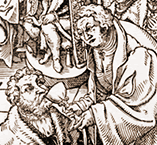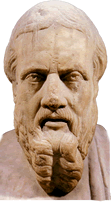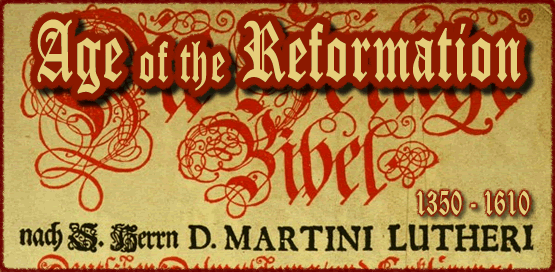|
|
|
|
 Holy Communion
Holy Communion
 |
|

 Europe in the Sixteenth CenturyBy Andrew Pettegree 
Chapter 1:
Describe the landscape and environment of sixteenth-century Europe and how it differed from the present. How did sixteenth-century Europeans experience and calculate time? What was the diet and longevity of people during the sixteenth century? Describe the role of the supernatural and the next life in the worldview of sixteenth-century Europeans. 
Chapter 2: What was the nature of political power and territorial rule in 1500? Describe how Spain became a united kingdom? Describe, compare and contrast the fortunes of French and Burgundy during the fifteenth and early sixteenth centuries. Describe, compare, and contrast the political situations of England and Scotland during the fifteenth and early sixteenth centuries. What was the history of the political organization of Scandinavia and the Holy Roman Empire during the fifteenth and early sixteenth centuries? Define these terms:
Marriage alliance 
Chapter 3: What were the reasons that people living north of the Alps traveled to visit Italy (and provide some details)? Describe the major political regions of Italy and the nature of politics prior to the beginning of the Italian Wars in 1494. Who were the major players in the Italian Wars, what was the course of events and battles, and who were the winners and losers? What was the influence of the Italian Wars on Italy and the other European powers? What was the nature of continuing Italian influence in Europe? Define these terms:
Medici family 
Chapter 4: Describe the changes that took place in transportation and other technologies of Europeans during the fifteenth and sixteenth centuries. What was the nature of cities in the sixteenth century? Describe the legacies of the medieval period, their role in the economy, and their role in the provision of education. What were the technical innovations associated with printed books and what was the impact of printed books on sixteenth-century European society? Describe the natures and manifestations of Humanism and its significance for sixteenth-century Europe. 
Chapter 5: What was the condition of the Church in Germany on the eve of the Reformation? What were the conditions that made Germany particularly receptive to Martin Luther’s ideas? Why were Luther’s ideas not very successful outside of Germany? Define these terms:
Frederick the Wise 
Chapter 6: Describe the character and background of how Charles V became the greatest Christian ruler of the early sixteenth century. How did Charles V and his minister Gattinara attempt to rule his vast empire and what was their concept of Christian Universalism? Describe how the interaction of the Turkish threat, the wars with France, the Reformation, and Habsburg family feuds prevented Charles V from succeeding with his policies. Define these terms:
Revolt of the Communeros 
Chapter 7: What was the difference between the religious conflicts of the first half of the sixteenth century and those of the second half? Discuss the role of the Council of Trent along with the Jesuits and other new religious orders in the revival of Catholicism in the face of the Reformation. How did Calvinism provide the Protestantism with a second wind to continue the Reformation? What does Pettegree say about the concept of a “military revolution”? Describe the changes that occurred in European warfare during the sixteenth century. Define these terms:
Capuchins 
Chapter 8: What were the circumstances that lead to religious civil war in France in 1562? What contributed to the failure of Catherine de Medici’s efforts to bring about religious peace to France and lead to the Massacre of St. Bartholemew? How did the Huguenot movement fare in the years 1571-1584? How did Henry of Navarre gain the crown of France? What were the consequences of the French Wars of Religion? Define these terms:
Chmabre Ardente 
Chapter 9: Why was the Dutch revolt of the Protestants such a surprise in 1566? What was the history of the Reformation in the Netherlands from 1520-1566 in terms of its success and failure? Describe the events leading to the outbreak of the Dutch Revolt in 1566 and its renewal after 1567-1571. How did it both unite and divide the Dutch opposition to Philip II? Describe the course of the Dutch Revolt from 1572 to 1612. Why did the Dutch Revolt succeed when the Huguenot rebellion in France failed? Define these terms:
Margaret of Parma 
Chapter 10: Describe the sequence of religious changes that took place in England from 1540-1560. How did the Reformation occur in Scotland and how did it fare under Mary Queen of Scots? What was the role of Parliament in the government of Elizabeth I and how did it differ from other European legislative assemblies? How did England and Spain come into conflict and what was the result of their war? What was the situation of Protestantism in England when James VI of Scotland became its king in 1603? Define these terms:
George Wishart 
Chapter 11: Describe the character of Philip II of Spain including his contradictions and the conflicting opinions of historians. What were the problems that Philip II had to face during the first decade or more of his reign? What were the policies and actions of Philip II toward the Dutch rebels and their English allies? How successful was he and what was the condition of his empire upon his death in 1598? Define these terms:
Battle of St. Quentin 
Chapter 12: In 1492 and after, how familiar were Europeans with lands, peoples, and goods from other parts of the world? Describe the early voyages of discovery by the Portuguese and Spanish. How did the Spanish manage to conquer Mexico and Peru? What was the nature of the Spanish empire in the Americas in terms of its government and its economy? How did the French, England and Dutch challenge the control of the Spanish and Portuguese over their overseas empires? Define these terms:
Christopher Columbus 
Chapter 13: What was the situation of the lands of Eastern Europe on the eve of the Reformation? How did the Habsburg family become rulers of various Eastern European kingsdoms and how successful was their rule? What was the nature of the Ottoman Empire and how did the Christian peoples of Eastern Europe fare under its rule? Describe, compare, and contrast the kingdoms of Poland-Lithuania and Muscovy during the sixteenth century. Define these terms:
John a Lasco (Jan Laski) 
Chapter 14: How does Pettegree define the social purposes of art in early modern Europe? What were the various forms and purposes taken by Court Culture during the sixteenth century? What were the relationships between artists and patrons at the beginning of the sixteenth century and how did that relationship change over the next hundred years? How did the Reformation affect the visual arts, music, and architecture? Were there differences between the Lutheran and the Calvinist approach to the arts? What did architecture, pageants, sermons, and theater contribute to culture in the cities? How did the tavern and outdoor festivals contribute to the culture of the countryside? Define these terms:
Hans Holbein 
Chapter 15: Around 1600 which European conflicts had been resolved and which new conflicts had arisen to disturb the peace of Europe? How did the nature of the politics in various European states both change and persist during the sixteenth century? How did the material lives of Europeans change during the sixteenth century in terms of consumer goods such as food, household items, books, and the nature of the family? Printer FriendlyFor a printer-friendly version of this webpage, If you don't have the Reader on your pc,  |
|
|
|
Historian, author, teacher, and higher education administrator, Dr. Ronald H. Fritze is Dean of the College of Arts and Sciences at Athens State University in Athens, Alabama. Ron has written for CornDancer since 2004. |
|
|
|
|
